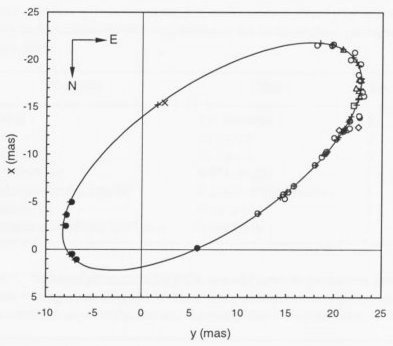
 |
The graph shows the orbit of one of the twin stars of Hadar (the bright star, Hadar A) as it appears to make its way around the other (which is at the intersection of the crossed lines). In reality, the two orbit a common center of mass that lies between them. The axes are in thousandths of a second of arc, with north toward the bottom, as is traditional in double star astronomy. The star being orbited does not appear at the focus of the observed ellipse because the orbit does not lie flat against the sky, but is tilted through an angle of 67 degrees. The stars were closest on February 25, 2000 and again after successive intervals of the orbital period of 357 days. (From an article by J. Davis et al. in Monthly Notices of the Royal Astronomical Society, vol. 356, p. 1362, 2005.) |